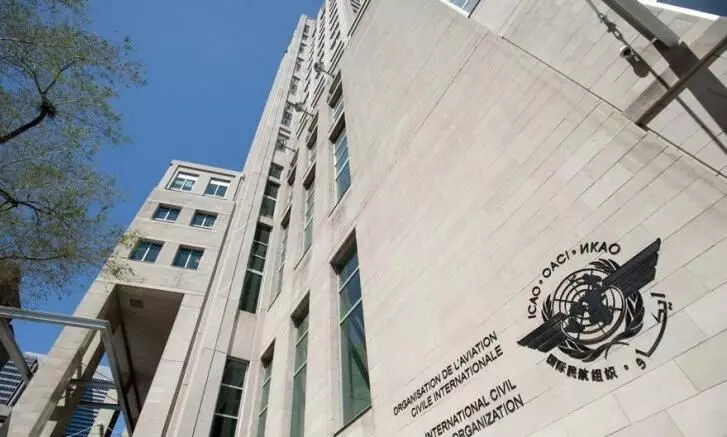
African govts, air cargo must seize opportunities offered by SAATM, AfCFTA
"Working in collaboration with multilateral institutions such as AU, ICAO, the World Bank Group and others, they can together ensure close alignment and maximize effective implementation of both."

Africa's share in global air cargo movement is insignificant to put it simply. There are many regulatory and infrastructural challenges that the continent faces while it intends to capture more air cargo volume and improve its economic landscape. However, there are rays of hope that businesses and the African air cargo community could see. While the African nations are showing their attention and intention towards improving connectivity, both inside and outside the continent, the International Civil Aviation Organization (ICAO) is facilitating many of these discussions and negotiations.
Cortney Robinson, air transport officer (air cargo) at ICAO recently spoke to The STAT Trade Times on the same.
Cortney Robinson
Can you put the African air cargo industry into context? How well-equipped are the African airports with modern infrastructure and cargo handling facilities? What needs to be expected in the next two years?
Africa’s world share of air cargo stands at 1.9 percent as of November 2022, which represents an increase over the pre-pandemic 1.7 percent reported for April 2019 International Air Transport Association (IATA). ICAO data reveals that world cargo traffic in September 2022 was -3.6 per cent below the 2019 level. Air cargo demand continued to soften facing various headwinds such as high-interest rates, rising inflation, reduced consumer online spending as well as weak international export demand. However, performance diverged across regions: Africa and North America continued to outperform and achieved double-digit growth over the pre-pandemic levels, while cargo traffic of the other regions posted slight deterioration and remained below the pre-pandemic level.
Policy levers including the Single African Air Transport Market (SAATM) and the Africa Continental Free Trade Agreement (AfCTFA) can create fertile ground for the African air cargo industry to continue and even increase its rate of growth through improved regional connectivity, as well as with markets in other regions.
The Covid-19 response placed a strong focus on cargo handling facilities, owing partially to the need for cold-chain warehousing for vaccines, as well as for personal protective equipment (PPE). For example, Ethiopian Airlines invested in a new cargo terminal in Addis Ababa, which received IATA’s Center of Excellence for Independent Validators in Pharmaceutical Logistics (CEIV Pharma) in 2021. Moreover, this cargo-specific infrastructure can also be used for commercial activities such as e-commerce.
It is noted that the level of economic development among African countries varies. Aviation is one of the flagship industries of economic development in Africa and often reflects the governments’ ambitions and actions. The Covid-19 pandemic underlined the limitations of airport infrastructures in Africa. Daily operational magnitude in hubs like Addis Ababa, Nairobi, Cairo, Johannesburg, and Accra are comparable to operations in European airports. However, there are several capital airports in Africa (including those in Central and Sahel regions) having limited infrastructure, and subsequently, the throughput of cargo transported via those airports is reduced due to insufficient apron space, single runway configurations, cargo ramps, storage facility, etc. Nevertheless, equipment is almost always present and functional for the types of aircraft permitted to operate into such airports.
Expectations over the next two years include:
- Fuel prices – Along with the broader economy, fuel prices will remain difficult to predict. One African ground handling enterprise noted its airline customers reported oil prices accounting for 30-35 per cent of their operational costs.
- Innovation – The African air cargo industry is continuing to invest in innovation, including digitalized processes and infrastructure in order to boost safety, security, and operational efficiency as cargo volumes continue their long-term growth.
Additionally, drone operations are growing continuously and achieving increased accessibility of cargo around the continent. The development of new and innovative business concepts and models will be essential for the growth of air cargo in Africa, taking into account the unique characteristics applied to air cargo.
Are the investments and funding coming into African air cargo for the right reasons and direction? What needs to be done?
As mentioned by the African Civil Aviation Commission (AFCAC) during a Workshop on the SAATM Project Implementation Plan (PIP) on the occasion of the ICAO Air Services Negotiation Event (ICAN) 2022, held in Abuja, Nigeria, investments and funding continue flowing into the African market: the SAATM is working actively with development partners, including the African Development Bank, World Bank and local commercial banks. Infrastructure providers such as MSC, Kuehne+Nagel, and National Aviation Services continue to announce acquisitions, as well as strategic alliances. Moreover, African-owned and operated carriers continue to invest in new fleets—both cargo freighters (wide and narrow-body) and drones. The AfCFTA could require a doubling of the cargo tonnage transported by air to 4.5 million. This translates to investment in 254 new aircraft at a cost of $35 billion by 2030.
Cargo theft and security are the issues we often hear from African countries. Can we expect more security breaches or fewer and why?
ICAO has recently published updated editions of several aviation security relevant documents, which include new regulatory changes (Annex 17), advice on the risk picture (ICAO Aviation Security Global Risk Context Statement), and guidance on the implementation of measures (Aviation Security Manual). These updates account for new or increased threats due to the Covid-19 pandemic. They can assist states in strengthening their civil aviation systems’ security posture (including air cargo) if implemented.
How far are regulations and governments influencing the African air cargo market? What we should expect from these changes including the ICAO ICAN 2022?
The African air cargo market has been subject to the Yamoussoukro Decision of 1999 (YD) for two decades and its implementation has been slow. In 2014, stakeholders convened at the First ICAO Meeting on Air Cargo Development in Africa and adopted the Lomé Declaration, which was then strengthened by the Addis Roadmap at the Second ICAO Meeting on Air Cargo Development in 2017. Lomé began by recognizing air cargo as a catalyst for economic growth through increased competitiveness that could generate foreign direct investment and thus economic development. During the Second Meeting, stakeholders reviewed the progress towards implementation of the Lomé Declaration and identified challenges and opportunities to inform a Roadmap for priority action. With these two instruments, ICAO Member States resolved to affirm their intent for implementation of strategic decisions taken in support of the sustainable development of air cargo transportation in Africa, through actions including:
Implementation of the YD, particularly its provisions on air cargo services to:
- Liberalize market access; and
- Facilitate further liberalization of air cargo services.
- Digitalization of cross-border trade processes;
- Promotion of/assistance to ratification of Montreal Convention of 1999 (MC99); and
- Increase awareness of ICAO’s policies and guidance material on funding of infrastructure.
Following these two meetings, ICAO developed the State Air Transport Action Plan System (SATAPS) to support States in their implementation of the YD, and to this day ICAO continues to encourage its application.
Most recently, the SAATM PIP Roadmap and the entry into force of the AfCFTA stand to play key roles in the African States. The former instrument creates the possibility to vastly expand the Fifth Freedom of the Air in regard to traffic rights for both passengers and cargo, among other benefits.
The AfCFTA is poised to drive economic development by facilitating large volumes of trade across Africa for both large enterprises and small and medium-sized enterprises (SMEs). The air cargo industry must make its value proposition clear to policymakers so that they can make effective use of the African air cargo infrastructure assets through their implementation efforts.
ICAO guidance encourages stakeholder consultation by States. Importantly for industry, the SAATM PIP designates specific activities and roles (e.g., SAATM Ambassador) for industry stakeholders to facilitate this consultation. Over the next two years and beyond, African air cargo stakeholders should actively participate in SAATM PIP workshops and other activities.
Through participation in State level engagements, as well as SAATM and AfCFTA engagements, African air cargo stakeholders can contribute to needed political will to advance the implementation of both these instruments while also taking away knowledge that will help them apply the policies flowing from these agreements to growing their enterprises. AFCAC aims to identify at least three States to participate in the SAATM PIP, therefore the air cargo stakeholders located in any selected States should ready themselves to contribute to the implementation process. Moreover, AfCFTA and AFCAC have already laid the groundwork by assessing cross-border trade to identify goods that can be transported by air while the former is finalizing the Trade and Services Protocol of the AfCFTA.
ICAN 2023 will take place in Saudi Arabia. The agenda will be responsive to the needs of the ICAO Member States conducting negotiations. This is another example of why air cargo stakeholders must engage their governments in order to generate a mutual understanding of needs, benefits and priorities. This cooperation would set the stage for States to negotiate agreements that would deliver benefits for their countries.
For safety and security, ICAO sets international Standards and Recommended Practices (SARPs) that, while ensuring sufficient air cargo security measures are in place, also allow for smooth and quick air cargo operations. Implementation of these SARPs is the responsibility of national civil aviation authorities, and the influence these measures may have on the air cargo market is dependent on how they are implemented and monitored by the aforementioned national authorities.
Do you see the regions in the continents are well supplied with air cargo capacity, particularly after Covid-19? How do you see the air freight rates and their competition with sea freight evolving?
The Covid-19 pandemic led to an increase in the number of cargo freighters on order, plus those awaiting conversion from passenger to freighter. In addition to economic headwinds, consumers trading off goods purchases (e.g., e-commerce) for travel has depressed cargo demand globally. This results in unutilized cargo capacity.
This unutilized capacity will naturally lead to decreased rates. Further, on a cost basis, air cargo is at a disadvantage compared to maritime transport due to the higher cost of air transport. Nonetheless, the unmatched speed and reliability of air cargo is the reason that it continues to carry 35 per cent of goods by value.
The year 2022 saw the trend of leading maritime carriers—MSC, Maersk and CMA-CGM—acquiring or establishing air fleets to expand their global network operations. Such multimodal fleets and the new business models they represent will blur the line between sea and air rates for customers.
Where do you see African air cargo in the next two years or what it should avoid?
Optimism surrounds African air cargo over the next two years, despite global economic uncertainty. Globally, there is a realization of and greater appreciation for the critical nature of air cargo and its role in the broader supply chain. African governments and the African air cargo industry must seize the opportunities offered by the SAATM and the AfCFTA. Working in collaboration with multilateral institutions such as the African Union (AU), ICAO, the World Bank Group and others, African States and Africa’s air cargo industry can together ensure close alignment between these two instruments—transport and trade together—so that States can maximize effective implementation of both. The next two years need to see stakeholders laying a strong foundation of policies that will facilitate an improved business environment for SMEs, e-commerce, investment, and broader economic development across the region.

